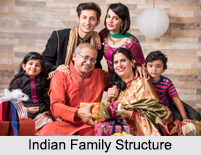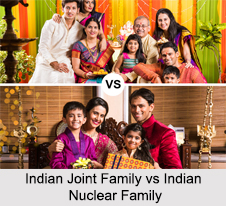 Indian Family Structure is believed to be the unit that teaches the values and worth of an honest living that have been carried down across generations. Since the Puranic ages, Indian family structure was that of a joint family, indicating every person of the same clan living together. However, this idea of elaborate living disintegrated in smaller family units.
Indian Family Structure is believed to be the unit that teaches the values and worth of an honest living that have been carried down across generations. Since the Puranic ages, Indian family structure was that of a joint family, indicating every person of the same clan living together. However, this idea of elaborate living disintegrated in smaller family units.
Concept of Indian Family Structure
In India, people learn the essential themes of cultural life within the bonding of a family. In ancient days, the basic units of society had been the patrilineal family unit with wider kinship groupings. Loyalty to family is a deeply imbibed in every member of the family.
Indian Joint Family
The most widely preferred residential unit is the joint family, ideally consisting of three or four patrilineally related generations. All living under one roof, working, worshiping, eating and cooperating together in communally beneficial social and economic activities. Patrilineal joint families include men related through the male line, along with their wives and children.
Numerous prominent Indian families, such as the Tata, Birla and Sarabhai, retain joint family arrangements even today and they work together to control some of the country`s largest financial empires.
The Indian joint family structure is an ancient phenomenon, but it has undergone some change in the late 20th century. Large families eventually face difficulties to suit with modern Indian life. The modern style of living, modern occupations and beliefs are eventually confronting problems to get adjusted. The joint family is now quite unfamiliar in cities. However, the relative ties are maintained within the kinships; since these very ties can prove to be crucial while any kind of emergency.
Indian Nuclear Family
With the passing time, nuclear families have evolved that is a couple living with their unmarried children. The Indian joint families grew even larger and finally they divide into smaller units, passing through an expected cycle over time. The breakup of a joint family into smaller units does not necessarily symbolize the rejection of the joint family ideal. Rather, it is usually a reaction to a variety of conditions, including the requirement for some members to move from village to city, or from one city to another to obtain the advantage of employment opportunities.
 Various other Indian Family Structures
Various other Indian Family Structures
Some Indian family structure bears special mention because of their unique qualities. In the sub-Himalayan region of Uttar Pradesh, polygyny is generally practiced. A polygynous family comprises a man, his two wives, and their unmarried children. Various other Indian family structures occur there, including the supplemented sub-polygynous household, where a woman whose husband lives elsewhere, stays with her children and other adult relatives. Among the Buddhist people of the mountainous Ladakh District of Jammu and Kashmir, fraternal polyandry is practiced; a household may include a set of brothers with their common wife or wives.
The inhabitants of the north-eastern hill areas are known for their matrilineal order that distinguish the decent and inheritance of a family in the female line rather than the male line. One of the largest of these groups, the Khasis of Meghalaya is divided into matrilineal clans. Here, the youngest daughter receives almost all of the inheritance including the house. A Khasi husband lives in his wife"s house.
Thus, Indian family structure has been varied with the period of time and in different regions of the nation. The society structure and regulations have the highest influence on such formations of Indian family structures.




















